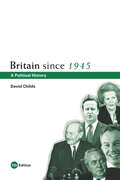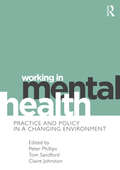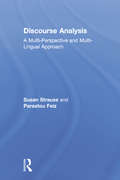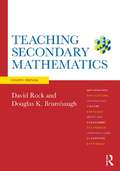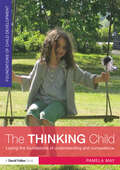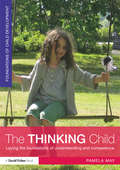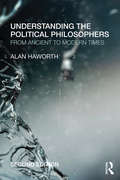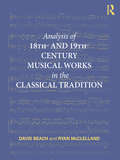- Table View
- List View
Britain since 1945: A Political History
by David ChildsBritain since 1945 is the established textbook on contemporary British political history since the end of the Second World War. David Childs' authoritative chronological survey discusses domestic policy and politics in particular, but also covers external and international relations. This new and improved seventh edition of this important book brings the picture to the present by including the following additions: Tony Blair's resignation and Gordon Brown's accession to power immigration the financial crisis from 2007: the first bank run in Britain since 1866 the 'Special-relationship' with the US and Obama the 2010 General elcetion and the first coalition government since 1945 'Broken Britain' and Crime the era of ‘owned by China' and Britain’s place in a turbulent world. Britain since 1945 is essential reading for any student of contemporary British history and politics.
High-Technology Entrepreneurship
by Ray OakeyWith the global economy in a precarious position, nurturing new entrepreneurial high-technology firms is likely to comprise a key component of any policy to encourage economic growth, both in developed and developing countries. Recent high-technology ventures – such as retailing in the music industry – have shown how entrepreneurs can radically change, or even replace, the structure of existing industries. High-Technology Entrepreneurship introduces and analyzes all the major aspects of high-technology small-firm formation and growth. Locational and functional aspects of the process, as well as how contexts for development may vary between developed and developing economies are also discussed. Other key topics that are addressed include: how high technology firms originate in theory and practice entrepreneurship theory incubators, science parks and clustering entrepreneurial strategy and finance. Students taking Master's-level courses in entrepreneurship, technology, innovation, academic enterprise and industrial development will find this an essential textbook for completing their studies.
High-Technology Entrepreneurship
by Ray OakeyWith the global economy in a precarious position, nurturing new entrepreneurial high-technology firms is likely to comprise a key component of any policy to encourage economic growth, both in developed and developing countries. Recent high-technology ventures – such as retailing in the music industry – have shown how entrepreneurs can radically change, or even replace, the structure of existing industries. High-Technology Entrepreneurship introduces and analyzes all the major aspects of high-technology small-firm formation and growth. Locational and functional aspects of the process, as well as how contexts for development may vary between developed and developing economies are also discussed. Other key topics that are addressed include: how high technology firms originate in theory and practice entrepreneurship theory incubators, science parks and clustering entrepreneurial strategy and finance. Students taking Master's-level courses in entrepreneurship, technology, innovation, academic enterprise and industrial development will find this an essential textbook for completing their studies.
Women Entrepreneurs: Inspiring Stories from Emerging Economies and Developing Countries
by Mauro F. GuillénWomen Entrepreneurs offers a collection of almost two dozen cases that explore the process by which women become entrepreneurs, as well as the opportunities and challenges they face in growing their businesses. With a particular focus on the intersection between entrepreneurship and economic development, the cases are drawn from across a range of industries and countries. They offer insights into a number of issues women entrepreneurs face, such as launching a business, diversification and internationalization, as well as covering a number of business functions, including finance, marketing and human resource management. Each case is presented with a summary highlighting the themes it covers, and ends with a set of questions to guide classroom discussion. The book also includes a summary of existing literature on entrepreneurship to help contextualize the cases. This casebook would be the ideal companion in an entrepreneurship class, particularly for students with an interest in female entrepreneurship or economic development. With data from a Goldman Sachs/Lauder Institute study.
Women Entrepreneurs: Inspiring Stories from Emerging Economies and Developing Countries
by Mauro F. GuillénWomen Entrepreneurs offers a collection of almost two dozen cases that explore the process by which women become entrepreneurs, as well as the opportunities and challenges they face in growing their businesses. With a particular focus on the intersection between entrepreneurship and economic development, the cases are drawn from across a range of industries and countries. They offer insights into a number of issues women entrepreneurs face, such as launching a business, diversification and internationalization, as well as covering a number of business functions, including finance, marketing and human resource management. Each case is presented with a summary highlighting the themes it covers, and ends with a set of questions to guide classroom discussion. The book also includes a summary of existing literature on entrepreneurship to help contextualize the cases. This casebook would be the ideal companion in an entrepreneurship class, particularly for students with an interest in female entrepreneurship or economic development. With data from a Goldman Sachs/Lauder Institute study.
Working in Mental Health: Practice and Policy in a Changing Environment
by Peter Phillips Tom Sandford Claire JohnstonA paradigm shift in the ways in which mental health services are delivered is happening—both for service users and for professional mental healthcare workers. The landscape is being changed by a more influential service user movement, a range of new community-based mental healthcare programmes delivered by an increasing plurality of providers, and new mental health policy and legislation. Written by a team of experienced authors and drawing on their expertise in policy and clinical leadership, Working in Mental Health: Practice and Policy in a Changing Environment explains how mental health services staff can operate and contribute in this new environment. Divided into three parts, the first focuses on the socio-political environment, incorporating service user perspectives. The second section looks at current themes and ways of working in mental health. It includes chapters on recovery, the IAPT programme, and mental healthcare for specific vulnerable populations. The final part explores new and future challenges, such as changing professional roles and commissioning services. The book focuses throughout on the importance of public health approaches to mental healthcare. This important text will be of interest to all those studying and working in mental healthcare, whether from a nursing, medical, social work or allied health background.
Sustainable Development (Routledge Introductions to Environment: Environment and Society Texts)
by Susan BakerThe current focus on sustainable development opens up debates surrounding our relationship with the natural world, about what constitutes social progress and about the character of development, both in the Global North and the Global South. The promotion of sustainable futures is taking on a new urgency in the context of climate change and biodiversity loss. This concise and accessible text explores how the international community is responding to the challenge of sustainable development. It also investigates the prospect for, and barriers to, the promotion of sustainable development in high-consumption societies of the industrialised world, from the USA and the EU to the economies of transition in Eastern and Southern Asia. In Sustainable Development Baker considers the global impact of China’s industrial boom as well as how Chinese investments are shaping the prospects for sustainable development on the African continent. This global coverage is balanced by investigating how local action, ranging from the transition towns movement in the UK to the Green Belt movement in Kenya, can contribute to the pursuit of sustainable development. The second edition has been extensively revised and updated and benefits from the addition of three new chapters: sustainable development in China; the governance of sustainable development; and sustainable production and consumption. Climate change and biodiversity management have also been expanded into full chapters. Providing an up-to-date and comprehensive treatment of the issues surrounding the promotion of sustainable development, this unique, internationally-focused book combines a strong conceptual analysis with wide ranging empirical focus and a wealth of case material. Including summary points and suggestions for further reading, as well as web resources and an extensive bibliography, it is ideal for students, scholars and researchers in the fields of environmental sciences, politics, geography, sociology and development studies.
Building Services Engineering
by David V. ChaddertonEngineering services within buildings account for ongoing energy use, greenhouse gas contribution and life safety provisions. This fully updated sixth edition of David Chadderton's leading textbook is the perfect preparation for those intending to enter this increasingly important field. Chapters addressing heating, climate change, air conditioning, transportation systems, water, gas, electricity, drainage and room acoustics cover all the key responsibilities of the building services engineer. As well as introductory material and the underpinning theory, practical guidance is provided in the form of sample calculations and spreadsheets. New material includes: trends and recent applications in lowering the energy use by mechanical and electrical services systems, heating, cooling and lighting of buildings case studies modelled from post-occupancy reports to provide realistic discussion topics examples of the use of photovoltaic solar panels, chilled beams, under floor air distribution, labyrinths, ground-sourced heat pumps, district heating and cooling, energy performance certificates, energy auditing and wind turbines outlines of the concepts of global warming, carbon trading and zero carbon buildings. exercises in each chapter and online self-study questions. A significantly expanded companion site offers over 1,000 self-test questions, powerpoint slides for lecturers, and an instructors' manual, enabling the rapid generation of lectures, assignments, and tests. This is the ideal textbook for students of building services engineering, as well as a comprehensive guide for those about to start work.
Building Services Engineering
by David V. ChaddertonEngineering services within buildings account for ongoing energy use, greenhouse gas contribution and life safety provisions. This fully updated sixth edition of David Chadderton's leading textbook is the perfect preparation for those intending to enter this increasingly important field. Chapters addressing heating, climate change, air conditioning, transportation systems, water, gas, electricity, drainage and room acoustics cover all the key responsibilities of the building services engineer. As well as introductory material and the underpinning theory, practical guidance is provided in the form of sample calculations and spreadsheets. New material includes: trends and recent applications in lowering the energy use by mechanical and electrical services systems, heating, cooling and lighting of buildings case studies modelled from post-occupancy reports to provide realistic discussion topics examples of the use of photovoltaic solar panels, chilled beams, under floor air distribution, labyrinths, ground-sourced heat pumps, district heating and cooling, energy performance certificates, energy auditing and wind turbines outlines of the concepts of global warming, carbon trading and zero carbon buildings. exercises in each chapter and online self-study questions. A significantly expanded companion site offers over 1,000 self-test questions, powerpoint slides for lecturers, and an instructors' manual, enabling the rapid generation of lectures, assignments, and tests. This is the ideal textbook for students of building services engineering, as well as a comprehensive guide for those about to start work.
Globalization: The Return of Borders to a Borderless World?
by Richard W. Mansbach Yale H. FergusonWritten by two leading scholars of global politics, Globalization: the return of borders to a borderless world? is a major new book for students of globalization. It describes and explains globalization and its origins, and examines its future in light of key recent political and global trends and events. The text: identifies the different political, economic, technological, and cultural meanings of globalization examines its historical origins from the ancient past through the Cold War and into the twenty-first century describes the multiple attributes and consequences of globalization including its effect on the sovereignty of the nation state discusses recent trends such as the increased use of social media and events like the Arab Spring assesses the normative implications of globalization analyzes the challenges to globalization posed by contemporary events such as the global financial crisis. This book will be essential reading for all students of globalization, and will be of great interest to students of global politics and global governance.
Transatlantic Relations since 1945: An Introduction
by Barbara Zanchetta Jussi Hanhimaki Benedikt SchoenbornTransatlantic Relations Since 1945 offers a comprehensive account of transatlantic relations in the second half of the 20th century (extending to the present-day). The transatlantic relationship has been the bedrock of international relations since the end of World War II. This new textbook will focus on the period since the defeat of Nazi Germany, when the multitude of links between United States and Western Europe were created, extended, and multiplied. Written in an accessible style, it emphasizes transatlantic interactions, and avoids the temptation to focus on either U.S. ‘domination’ or European attempts to ‘resist’ an American effort to subjugate the old continent. That influence has travelled across the Atlantic in both directions is one of the starting points of this text. Structured chronologically, the book will be built around three key themes: Security: From the Cold War to the War on Terror Economics: Integration and Competition ‘Soft power’ and Transatlantic Relations. This book will be of great interest to students of transatlantic relations, NATO, US Foreign Policy, Cold War History, European History and IR/International history.
Teaching Contemporary Themes in Secondary Education: Technology, Culture and Communication
by Jonathan Savage Clive McGounThe media has a huge impact on how we view society and the world, and new technologies continue to transform the way in which we work and learn. It is therefore essential that young people can engage critically in their consumption of media and the internet and are able to make informed decisions about the technologies they use. This book explores the broad contexts and ideas that technology facilitates in our culture and considers what this means for teachers in practice. It aims to help you develop your understanding about, and pedagogy with, technology and includes: the implications of new media and technology on twenty-first century education; guidance on choosing and using digital technologies and how these affect the educational opportunities for young people; a consideration of students’ critical and creative thinking with digital media and their confidence and autonomy in digital consumption and production; references to recent research to support practice; Links to resources and organisations who can offer support. Technology has a crucial role to play in processes of teaching and learning. This book is essential reading for trainee and practising teachers that wish to use a range of technological tools to form a dynamic and creative learning environment.
China and Globalization: The Social, Economic and Political Transformation of Chinese Society
by Doug GuthrieChoice Outstanding Academic Title 2009! In its quarter-century-long shift from communism to capitalism, China has transformed itself from a desperately poor nation into a country with one of the fastest-growing and largest economies in the world. Doug Guthrie examines the reforms driving the economic genesis in this compact and highly readable introduction to contemporary China. He highlights the social, cultural and political factors fostering this revolutionary change and interweaves a broad structural analysis with a consideration of social changes at the micro and macro levels. In this new, revised edition author Guthrie updates his story on modern China and provides the latest authoritative data and examples from current events to chart where this dynamically changing society is headed and what the likely consequences for the rest of the world will be.
China and Globalization: The Social, Economic and Political Transformation of Chinese Society
by Doug GuthrieChoice Outstanding Academic Title 2009! In its quarter-century-long shift from communism to capitalism, China has transformed itself from a desperately poor nation into a country with one of the fastest-growing and largest economies in the world. Doug Guthrie examines the reforms driving the economic genesis in this compact and highly readable introduction to contemporary China. He highlights the social, cultural and political factors fostering this revolutionary change and interweaves a broad structural analysis with a consideration of social changes at the micro and macro levels. In this new, revised edition author Guthrie updates his story on modern China and provides the latest authoritative data and examples from current events to chart where this dynamically changing society is headed and what the likely consequences for the rest of the world will be.
Discourse Analysis: Putting Our Worlds into Words
by Susan Strauss Parastou FeizThis introductory textbook presents a variety of approaches and perspectives that can be employed to analyze any sample of discourse. The perspectives come from multiple disciplines, including linguistics, sociolinguistics, and linguistic anthropology, all of which shed light on meaning and the interactional construction of meaning through language use. Students without prior experience in discourse analysis will appreciate and understand the micro-macro relationship of language use in everyday contexts, in professional and academic settings, in languages other than English, and in a wide variety of media outlets. Each chapter is supported by examples of spoken and written discourse from various types of data sources, including conversations, commercials, university lectures, textbooks, print ads, and blogs, and concludes with hands-on opportunities for readers to actually do discourse analysis on their own. Students can also utilize the book’s comprehensive companion website, with flash cards for key terms, quizzes, and additional data samples, for in-class activities and self-study. With its accessible multi-disciplinary approach and comprehensive data samples from a variety of sources, Discourse Analysis is the ideal core text for the discourse analysis course in applied linguistics, English, education, and communication programs.
Discourse Analysis: Putting Our Worlds into Words
by Susan Strauss Parastou FeizThis introductory textbook presents a variety of approaches and perspectives that can be employed to analyze any sample of discourse. The perspectives come from multiple disciplines, including linguistics, sociolinguistics, and linguistic anthropology, all of which shed light on meaning and the interactional construction of meaning through language use. Students without prior experience in discourse analysis will appreciate and understand the micro-macro relationship of language use in everyday contexts, in professional and academic settings, in languages other than English, and in a wide variety of media outlets. Each chapter is supported by examples of spoken and written discourse from various types of data sources, including conversations, commercials, university lectures, textbooks, print ads, and blogs, and concludes with hands-on opportunities for readers to actually do discourse analysis on their own. Students can also utilize the book’s comprehensive companion website, with flash cards for key terms, quizzes, and additional data samples, for in-class activities and self-study. With its accessible multi-disciplinary approach and comprehensive data samples from a variety of sources, Discourse Analysis is the ideal core text for the discourse analysis course in applied linguistics, English, education, and communication programs.
Teaching Secondary Mathematics
by David Rock Douglas K. BrumbaughSolidly grounded in up-to-date research, theory and technology,?Teaching Secondary Mathematics?is a practical, student-friendly, and popular text for secondary mathematics methods courses. It provides clear and useful approaches for mathematics teachers, and shows how concepts typically found in a secondary mathematics curriculum can be taught in a positive and encouraging way. The thoroughly revised fourth edition combines this pragmatic approach with truly innovative and integrated technology content throughout. Synthesized content between the book and comprehensive companion website offers expanded discussion of chapter topics, additional examples and technological tips. Each chapter features tried-and-tested pedagogical techniques, problem solving challenges, discussion points, activities, mathematical challenges, and student-life based applications that will encourage students to think and do. New to the 4th edition: A fully revised and updated chapter on technological advancements in the teaching of mathematics Connections to both the updated NCTM Focal Points as well as the new Common Core State Standards are well-integrated throughout the text Problem solving challenges and sticky questions featured in each chapter to encourage students to think through everyday issues and possible solutions. A fresh interior design to better highlight pedagogical elements and key features A companion website with chapter-by-chapter video lessons, teacher tools, problem solving Q&As, helpful links and resources, and embedded graphing calculators.
Teaching Secondary Mathematics
by David Rock Douglas K. BrumbaughSolidly grounded in up-to-date research, theory and technology,?Teaching Secondary Mathematics?is a practical, student-friendly, and popular text for secondary mathematics methods courses. It provides clear and useful approaches for mathematics teachers, and shows how concepts typically found in a secondary mathematics curriculum can be taught in a positive and encouraging way. The thoroughly revised fourth edition combines this pragmatic approach with truly innovative and integrated technology content throughout. Synthesized content between the book and comprehensive companion website offers expanded discussion of chapter topics, additional examples and technological tips. Each chapter features tried-and-tested pedagogical techniques, problem solving challenges, discussion points, activities, mathematical challenges, and student-life based applications that will encourage students to think and do. New to the 4th edition: A fully revised and updated chapter on technological advancements in the teaching of mathematics Connections to both the updated NCTM Focal Points as well as the new Common Core State Standards are well-integrated throughout the text Problem solving challenges and sticky questions featured in each chapter to encourage students to think through everyday issues and possible solutions. A fresh interior design to better highlight pedagogical elements and key features A companion website with chapter-by-chapter video lessons, teacher tools, problem solving Q&As, helpful links and resources, and embedded graphing calculators.
The Thinking Child: Laying the foundations of understanding and competence
by Pamela MayWhat characteristics do children need to become motivated to learn? How do children’s experiences and relationships affect their cognitive development? How do you provide learning experiences that meet the developmental needs of every child in your care? The Thinking Child thoughtfully discusses the key principles of children’s cognitive and intellectual development alongside descriptions of everyday practice. It clearly explains the cognitive strategies that children use to learn new knowledge, the development of cognitive milestones such as symbolism, memories and the imagination, metacognition and creativity along with research into how the brain processes information. Throughout the book, the author considers the key characteristics of effective learning and shows how play is one of the primary mechanisms that children use to access new knowledge and to consolidate their emerging ideas and concepts. These characteristics are then applied to integral aspects of early years practice to show how pracitioners can: motivate children to learn new knowledge about themselves and the world around them; help children to develop their own ideas creatively and use this knowledge as a base to learn new things; reflect on their own teaching methods to encourage children’s engagement, motivation and creativity through effective observation and planning; engage with parents and carers to help support children’s learning at home whilst maintaining the values of the family; celebrate the uniqueness of each child and provide learning experiences that are appropriate for individuals with particular learning needs, be they physical, emotional or cognitive to ensure that every child has an equal opportunity to succeed. Emphasising the importance of understanding the theory that underpins children’s cognitive development, this accessible text shows practitioners how they can use this knowledge to provide learning opportunities that nourish children’s thinking and creative skills.
The Thinking Child: Laying the foundations of understanding and competence
by Pamela MayWhat characteristics do children need to become motivated to learn? How do children’s experiences and relationships affect their cognitive development? How do you provide learning experiences that meet the developmental needs of every child in your care? The Thinking Child thoughtfully discusses the key principles of children’s cognitive and intellectual development alongside descriptions of everyday practice. It clearly explains the cognitive strategies that children use to learn new knowledge, the development of cognitive milestones such as symbolism, memories and the imagination, metacognition and creativity along with research into how the brain processes information. Throughout the book, the author considers the key characteristics of effective learning and shows how play is one of the primary mechanisms that children use to access new knowledge and to consolidate their emerging ideas and concepts. These characteristics are then applied to integral aspects of early years practice to show how pracitioners can: motivate children to learn new knowledge about themselves and the world around them; help children to develop their own ideas creatively and use this knowledge as a base to learn new things; reflect on their own teaching methods to encourage children’s engagement, motivation and creativity through effective observation and planning; engage with parents and carers to help support children’s learning at home whilst maintaining the values of the family; celebrate the uniqueness of each child and provide learning experiences that are appropriate for individuals with particular learning needs, be they physical, emotional or cognitive to ensure that every child has an equal opportunity to succeed. Emphasising the importance of understanding the theory that underpins children’s cognitive development, this accessible text shows practitioners how they can use this knowledge to provide learning opportunities that nourish children’s thinking and creative skills.
Understanding the Political Philosophers: From Ancient to Modern Times
by Alan HaworthUnderstanding the Political Philosophers is an absorbing and accessible introduction to the major philosophers and core texts of western political philosophy. Organised historically - beginning with Socrates and Plato, and concluding with post-Rawlsian theory - Alan Haworth presents the key ideas and developments with clarity and depth. Each chapter provides a concentrated study of a given thinker or group of thinkers and together they constitute a broad account of the main arguments in political philosophy. There are chapters on Socrates, Plato, Aristotle, Hobbes, Locke, Rousseau, the Utilitarians, Marx, and Rawls’s early work. This revised second edition has been brought fully up-to-date, and includes expanded coverage of the period from the death of Aristotle to the sixteenth century, as well as a new chapter on Rawls’s later philosophy and the direction of post-Rawlsian philosophy. Including a chronology and suggestions for further reading, Understanding the Political Philosophers is an ideal introductory text for students taking courses in political philosophy or political theory.
Understanding the Political Philosophers: From Ancient to Modern Times
by Alan HaworthUnderstanding the Political Philosophers is an absorbing and accessible introduction to the major philosophers and core texts of western political philosophy. Organised historically - beginning with Socrates and Plato, and concluding with post-Rawlsian theory - Alan Haworth presents the key ideas and developments with clarity and depth. Each chapter provides a concentrated study of a given thinker or group of thinkers and together they constitute a broad account of the main arguments in political philosophy. There are chapters on Socrates, Plato, Aristotle, Hobbes, Locke, Rousseau, the Utilitarians, Marx, and Rawls’s early work. This revised second edition has been brought fully up-to-date, and includes expanded coverage of the period from the death of Aristotle to the sixteenth century, as well as a new chapter on Rawls’s later philosophy and the direction of post-Rawlsian philosophy. Including a chronology and suggestions for further reading, Understanding the Political Philosophers is an ideal introductory text for students taking courses in political philosophy or political theory.
Analysis of 18th- and 19th-Century Musical Works in the Classical Tradition
by David Beach Ryan McClellandAnalysis of 18th- and 19th-Century Musical Works in the Classical Tradition is a textbook for upper-level undergraduate and graduate courses in music analysis. It outlines a process of analyzing works in the Classical tradition by uncovering the construction of a piece of music—the formal, harmonic, rhythmic, and voice-leading organizations—as well as its unique features. It develops an in-depth approach that is applied to works by composers including Haydn, Mozart, Beethoven, Schubert, Schumann, and Brahms. The book begins with foundational chapters in music theory, starting with basic diatonic harmony and progressing rapidly to more advanced topics, such as phrase design, phrase expansion, and chromatic harmony. The second part contains analyses of complete musical works and movements. The text features over 150 musical examples, including numerous complete annotated scores. Suggested assignments at the end of each chapter guide students in their own musical analysis.
Analysis of 18th- and 19th-Century Musical Works in the Classical Tradition
by David Beach Ryan McClellandAnalysis of 18th- and 19th-Century Musical Works in the Classical Tradition is a textbook for upper-level undergraduate and graduate courses in music analysis. It outlines a process of analyzing works in the Classical tradition by uncovering the construction of a piece of music—the formal, harmonic, rhythmic, and voice-leading organizations—as well as its unique features. It develops an in-depth approach that is applied to works by composers including Haydn, Mozart, Beethoven, Schubert, Schumann, and Brahms. The book begins with foundational chapters in music theory, starting with basic diatonic harmony and progressing rapidly to more advanced topics, such as phrase design, phrase expansion, and chromatic harmony. The second part contains analyses of complete musical works and movements. The text features over 150 musical examples, including numerous complete annotated scores. Suggested assignments at the end of each chapter guide students in their own musical analysis.
Governing Metropolitan Areas: Growth and Change in a Networked Age
by David K. HamiltonInterest and research on regionalism has soared in the last decade. Local governments in metropolitan areas and civic organizations are increasingly engaged in cooperative and collaborative public policy efforts to solve problems that stretch across urban centers and their surrounding suburbs. Yet there remains scant attention in textbooks to the issues that arise in trying to address metropolitan governance. Governing Metropolitan Areas describes and analyzes structure to understand the how and why of regionalism in our global age. The book covers governmental institutions and their evolution to governance, but with a continual focus on institutions. David Hamilton provides the necessary comprehensive, in-depth description and analysis of how metropolitan areas and governments within metropolitan areas developed, efforts to restructure and combine local governments, and governance within the polycentric urban region.This second edition is a major revision to update the scholarship and current thinking on regional governance. While the text still provides background on the historical development and growth of urban areas and governments' efforts to accommodate the growth of metropolitan areas, this edition also focuses on current efforts to provide governance through cooperative and collaborative solutions. There is also now extended treatment of how regional governance outside the United States has evolved and how other countries are approaching regional governance.
